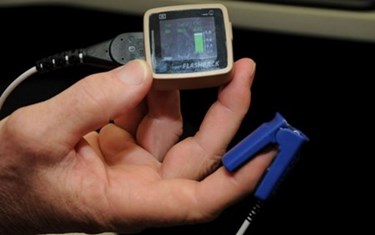U.S. Military Develops Blood-Loss Detection Device That Predicts Shock
By Jof Enriquez,
Follow me on Twitter @jofenriq

The United States military has developed a finger-worn device that can monitor blood loss and predict hemorrhagic shock well in advance compared to traditional vital sign monitors. The device could speed combat triage and be used to monitor other health conditions involving blood or fluid loss, including postpartum hemorrhage and dengue hemorrhagic fever.
Despite suffering internal injuries, patients can maintain stable blood pressure for some time because of the body's inherent compensatory mechanisms to offset blood loss. It is only when these mechanisms fail — the point of decompensation — that blood pressure suddenly drops and the patient "crashes" into shock, a medical emergency that can quickly take a fatal turn.
Medics can respond to an emergency more quickly if they have means to detect how a patient compensates before vital signs indicate early stages of shock. So, researchers at the U.S. Army Combat Casualty Care Research program at Joint Base San Antonio in Texas developed what is called the Compensatory Reserve Index (CRI) device, which measures the rate of decompensation, something that varies between individuals.
According to a study published in the journal Shock, the Compensatory Reserve Index (CRI) is a means of assessing physiologic reserve, shown to correlate with central blood volume loss under laboratory conditions. In this study, CRI was shown to be better than standard indices in detecting mild blood loss. Single measurement of CRI may enable a more accurate triage, the study says, and CRI monitoring may allow for earlier detection of casualty deterioration.
The matchbox-sized device measures a patient's CRI in real-time and displays readings extracted by the device's chip — which runs an algorithm that analyzes beat-to-beat changes in arterial pulse waveforms associated with the progression to hemodynamic decompensation — according to another study in the Journal of Trauma and Acute Care Surgery.
“It turns out that those features represent the sum total of all the compensatory mechanisms, so it’s the perfect thing to measure,” said Dr. Vic Convertino, senior scientist for the U.S. Army Combat Casualty Care Research program, to Stars and Stripes. “So now in real time we can determine those features and therefore determine the changes in the reserve to compensate for blood loss. When reserve gets to zero, that’s when people go into shock and we can actually determine how much of that reserve is left way early so that we give medics an early indicator.”
A prototype of the device is attached via a cable to a smart tablet, which medics can use in monitoring multiple wounded, according to the article. Researchers are working on incorporating the technology into the pulse oximeters currently used by medics, as well as how to connect them wirelessly.
The initial purpose of the technology is to reduce casualties from bleeding, the leading cause of death in the battlefield. However, the researchers say the CRI device is not restricted to military applications and could be used to monitor other health conditions caused by blood and fluid loss.
Researchers are already collaborating with the obstetrics department at Brooke Army Medical Center to monitor postpartum hemorrhage, a leading cause of maternal death in the developing world.
“Obstetricians often have difficulty recognizing the actual amount of bleeding and predicting how well the mother will compensate. With this tool, we believe we’re going to save the lives of mothers,” Convertino told Health.Mil.
Star and Stripes also says the device is also being used in a children's hospital in Bangkok, Thailand to monitor dengue hemorrhagic fever, a leading cause of hospitalization and death among children in Asia and the Americas.
“It could revolutionize how we take care of patients in both the pre-hospital as well as the hospital setting,” said Lt. Col. Will Smith, an emergency medicine physician in the Army Reserve, according to Health.Mil. “If this device can be validated and receive clinical approval, then it has an amazing potential to save lives.”
Clinical trial data have been submitted to the U.S. Food and Drug Administration (FDA) last year, and the device could receive 510(k) clearance before the end of 2015.
